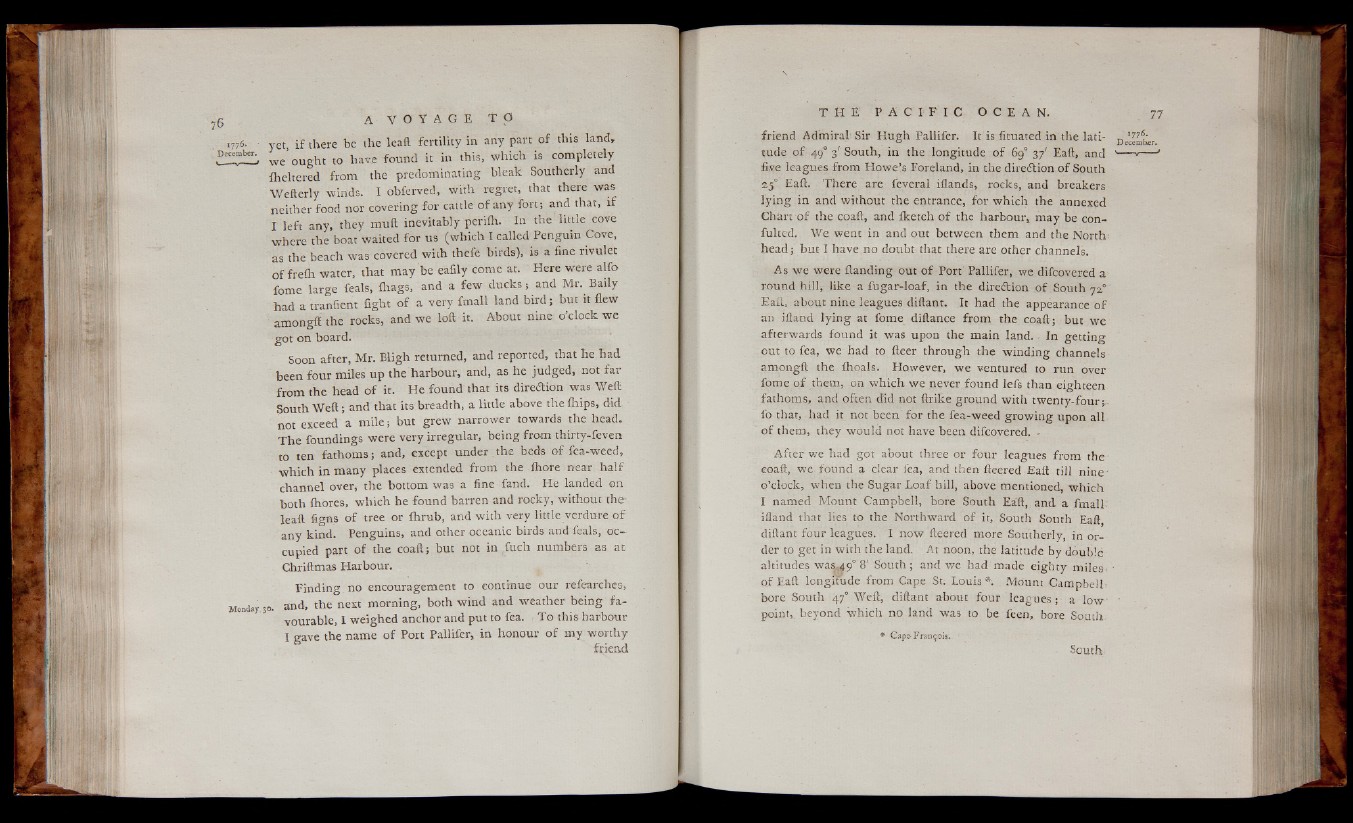
yet, if there be the leaft fertility in any part of this land,
we ought to have found it in this, which is completely
Iheltered from the predominating bleak Southerly and
Wefterly winds. I obferved, with regret, that there was
neither food nor covering for cattle of any fort; and that, if
I left any, they muft inevitably periih. In the little cove
where the boat waited for us (which I called Penguin Cove,
as the beach was covered with thefe birds), is a fine rivulet
of frefla water, that may be eafily come at. Here were alfo
fome large feals, ihags, and a few ducks,- and Mr. Baily
had a tranfient fight of a very fmall land bird; but it flew
among« the rocks, and we loft it. About nine o’clock we
got on board.
Soon after, Mr. Bligh returned, and reported, that he had
been four miles up the harbour, and, as he judged, not far
from the head of it. He found that its direction was Weft
South Weft; and that its breadth, a little above the ihips, did
not exceed a mile; but grew narrower towards the head.
The foundings were very irregular, being from thirty-feven
to ten fathoms; and, except under the beds of fea-weed,
which in many places extended from the fhore near half
channel over, the bottom was a fine fand. He landed on
both ihores, which he found barren and rocky, without the
leaft figns of tree or ihrub, and with very little verdure of
any kind. Penguins, and other oceanic birds and feals, occupied
part of the coaft; but not in ,fuch numbers as at
Chriftmas Harbour.
Finding no encouragement to continue our refearches,
o and, the next morning, both wind and weather being favourable,
I weighed anchor and put to fea. To this harbour
I gave the name of Port Pallifer, in honour of my worthy
friend
friend Admiral Sir Hugh Pallifer. It is fituated in the lati- „ S l l 0 December.
tude o f 49° 3' South, in the longitude of 69° 37' Eaft, and ' » '
five leagues from Howe’s Foreland, in the dire&ion of South
250 Eaft. There are feveral iflands, rocks, and breakers
lying in and without the entrance, for which the annexed
Chart of the coaft, and iketch of the harbour, may be con-
fulted. We went in and out between them and the North:
head; but I have no doubt that there are other channels.
As we were Handing out of Port Pallifer, we difcovered a
round hill, like a fugar-loaf, in the direction of South 72°
Eaft, about nine leagues diftant. It had the appearance of
an ifland lying at fome diftance from the coaft; but we
afterwards found it was upon the main land. In getting
out to fea, we had to fteer through the winding channels
amongft the fhoals. However, we ventured to run over
fome of them, on which we never found lefs than eighteen
fathoms, and often did not ftrike ground with twenty-four;
fo that, had it not been for the fea-weed growing upon all
of them, they would not have been difcovered. -
After we had got about three or four leagues from the
coaft, we found a clear fea, and then fleered Eaft till nine-
o’clock, when the Sugar Loaf hill, above mentioned, which
I named Mount Campbell, bore South Eaft, and a fmall
ifland that lies to the Northward of it, South South Eaft
diftant four leagues. I now fleered more Southerly, in order
to get in with the land. At noon, the latitude by double
altitudes waSja/ S' South; and we had made eighty m iles .-
of Eaft longitude from Cape St. Louis *. Mount Campbell,
bore South 47° Weft, diftant about four leagues; a low
point,, beyond which no land was to be feen, bore South
* Gape-François. -
South.